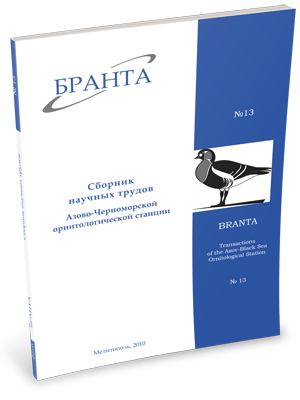
Transactions
of the Azov-Black Sea Ornithological Station



Long-term changes in timing of bird arrival in Kharkov region.
A. S. Nadtochiy, A. B. Chaplygina
Phenological observations of timing of spring arrival of birds in Kharkov region were taken over the period 1982-2010 in the forest-steppe zone, namely in Zmiev district, the vicinity of the village Gaydary, the biostation (since 2004 the territory of the National Natural Park ‘Gomolshansky Forests’), and in Kharkov City and neighbouring settlements (villages Pesochin, Manchenki, Solonitsevka, Podvorki). Comparative analysis of timing of bird arrival in Kharkov region over the period 1982-2010 and observation data by N.N.Somov (1897) (Table 1) have shown that for the majority of studied species (both short- and long-distance migrants) the last century was characterized by a noticeable shift of timing of spring migration to earlier calendar dates. Of 39 analyzed bird species according to the date of their first registration, 25 species began arriving earlier (from 2-3 days to 2 weeks), 10 species – later, and 4 species did not change the time of their arrival. The following species are now registered 7-9 days earlier: the Swift (Apus apus), Bee-eater (Merops apiaster), Golden Oriole (Oriolus oriolus), Savi’s Warbler (Locustella luscinioides), Sedge Warbler (Acrocephalus schoenobaenus), Blackcap (Sylvia atricapilla), Barred Warbler (S. nisoria), White Collared Flycatcher (Ficedula albicollis), Chaffinch (Fringilla coelebs). Two weeks earlier became the arrival of the Chiffchaff (Phylloscopus collybita) and Song Thrush (Turdus philomelos). According to comparative analysis and extreme and mean dates of arrival 13 species show the trend of earlier arrival in the late 20th –early 21st centuries, of them 11 species are long-distance migrants and 2 species are short-distance migrants.
Analysis of timing of spring arrival of 43 bird species in Kharkov region over the period from 1982 to 2010 has shown that all studied bird species have considerable fluctuations in arrival dates between years (Table 1). Difference between the earliest and the latest bird registration is one week to one month both for early and late arriving migrants. Among 29 species of long-distance migrants the earliest arriving species is the Chiffchaff (3d decade of March – 2nd decade of April, difference in timing of arrival is 25 days), the latest arriving birds are the Swift and Icterine Warbler (Hippolais icterina) (1st-2nd decades of May, difference in timing of arrival is 14 and 9 days correspondingly).
Analysis of long-term trends in timing of arrival of 12 species of birds (fig.2) have shown that 5 species such as the White Wagtail (Motacilla alba), Black Redstart (Phoenicurus ochruros), Wood Warbler (Phylloscopus sibilatrix), Blackcap and Swallow (Hirundo rustica) has an earlier arrival trend, 2 species – the Willow Warbler (Phylloscopus trochilus) and Coockoo (Cuculus canorus) – are characterized by a later arrival trend, other 5 species (the Chiffchaff, Bluethroat (Luscinia svecica), Golden Oriole, Wryneck (Jynx torquilla), Swift) have no noticeable trend of changes in dates of their arrival.
Fluctuations of timing of bird arrival are related with spring weather conditions, moreover with dynamics of spring air temperatures. Long-term trends of average monthly spring temperatures in Kharkov region (fig. 1) show that for March it is observed a trend of slight temperature increase while for April and May temperatures the trend is slightly decreasing.
Read the paper in a PDF file